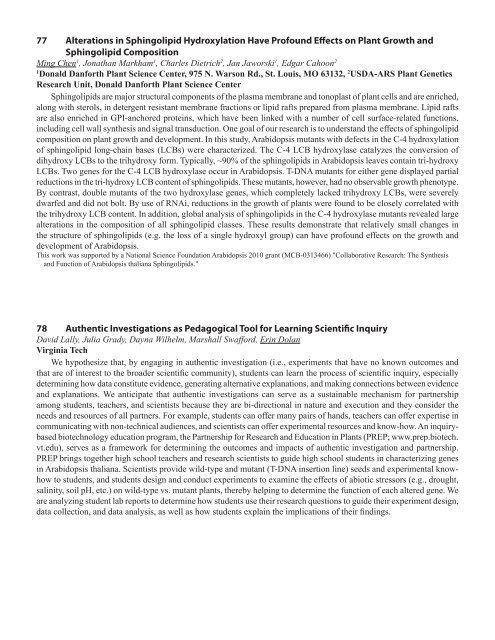75 Integrating Membrane Transport with Male Gametophyte ... - TAIR
75 Integrating Membrane Transport with Male Gametophyte ... - TAIR
75 Integrating Membrane Transport with Male Gametophyte ... - TAIR
You also want an ePaper? Increase the reach of your titles
YUMPU automatically turns print PDFs into web optimized ePapers that Google loves.
77 Alterations in Sphingolipid Hydroxylation Have Profound Effects on Plant Growth and<br />
Sphingolipid Composition<br />
Ming Chen 1 , Jonathan Markham 1 , Charles Dietrich 2 , Jan Jaworski 1 , Edgar Cahoon 2<br />
1<br />
Donald Danforth Plant Science Center, 9<strong>75</strong> N. Warson Rd., St. Louis, MO 63132, 2 USDA-ARS Plant Genetics<br />
Research Unit, Donald Danforth Plant Science Center<br />
Sphingolipids are major structural components of the plasma membrane and tonoplast of plant cells and are enriched,<br />
along <strong>with</strong> sterols, in detergent resistant membrane fractions or lipid rafts prepared from plasma membrane. Lipid rafts<br />
are also enriched in GPI-anchored proteins, which have been linked <strong>with</strong> a number of cell surface-related functions,<br />
including cell wall synthesis and signal transduction. One goal of our research is to understand the effects of sphingolipid<br />
composition on plant growth and development. In this study, Arabidopsis mutants <strong>with</strong> defects in the C-4 hydroxylation<br />
of sphingolipid long-chain bases (LCBs) were characterized. The C-4 LCB hydroxylase catalyzes the conversion of<br />
dihydroxy LCBs to the trihydroxy form. Typically, ~90% of the sphingolipids in Arabidopsis leaves contain tri-hydroxy<br />
LCBs. Two genes for the C-4 LCB hydroxylase occur in Arabidopsis. T-DNA mutants for either gene displayed partial<br />
reductions in the tri-hydroxy LCB content of sphingolipids. These mutants, however, had no observable growth phenotype.<br />
By contrast, double mutants of the two hydroxylase genes, which completely lacked trihydroxy LCBs, were severely<br />
dwarfed and did not bolt. By use of RNAi, reductions in the growth of plants were found to be closely correlated <strong>with</strong><br />
the trihydroxy LCB content. In addition, global analysis of sphingolipids in the C-4 hydroxylase mutants revealed large<br />
alterations in the composition of all sphingolipid classes. These results demonstrate that relatively small changes in<br />
the structure of sphingolipids (e.g. the loss of a single hydroxyl group) can have profound effects on the growth and<br />
development of Arabidopsis.<br />
This work was supported by a National Science Foundation Arabidopsis 2010 grant (MCB-0313466) "Collaborative Research: The Synthesis<br />
and Function of Arabidopsis thaliana Sphingolipids."<br />
78 Authentic Investigations as Pedagogical Tool for Learning Scientific Inquiry<br />
David Lally, Julia Grady, Dayna Wilhelm, Marshall Swafford, Erin Dolan<br />
Virginia Tech<br />
We hypothesize that, by engaging in authentic investigation (i.e., experiments that have no known outcomes and<br />
that are of interest to the broader scientific community), students can learn the process of scientific inquiry, especially<br />
determining how data constitute evidence, generating alternative explanations, and making connections between evidence<br />
and explanations. We anticipate that authentic investigations can serve as a sustainable mechanism for partnership<br />
among students, teachers, and scientists because they are bi-directional in nature and execution and they consider the<br />
needs and resources of all partners. For example, students can offer many pairs of hands, teachers can offer expertise in<br />
communicating <strong>with</strong> non-technical audiences, and scientists can offer experimental resources and know-how. An inquirybased<br />
biotechnology education program, the Partnership for Research and Education in Plants (PREP; www.prep.biotech.<br />
vt.edu), serves as a framework for determining the outcomes and impacts of authentic investigation and partnership.<br />
PREP brings together high school teachers and research scientists to guide high school students in characterizing genes<br />
in Arabidopsis thaliana. Scientists provide wild-type and mutant (T-DNA insertion line) seeds and experimental knowhow<br />
to students, and students design and conduct experiments to examine the effects of abiotic stressors (e.g., drought,<br />
salinity, soil pH, etc.) on wild-type vs. mutant plants, thereby helping to determine the function of each altered gene. We<br />
are analyzing student lab reports to determine how students use their research questions to guide their experiment design,<br />
data collection, and data analysis, as well as how students explain the implications of their findings.





